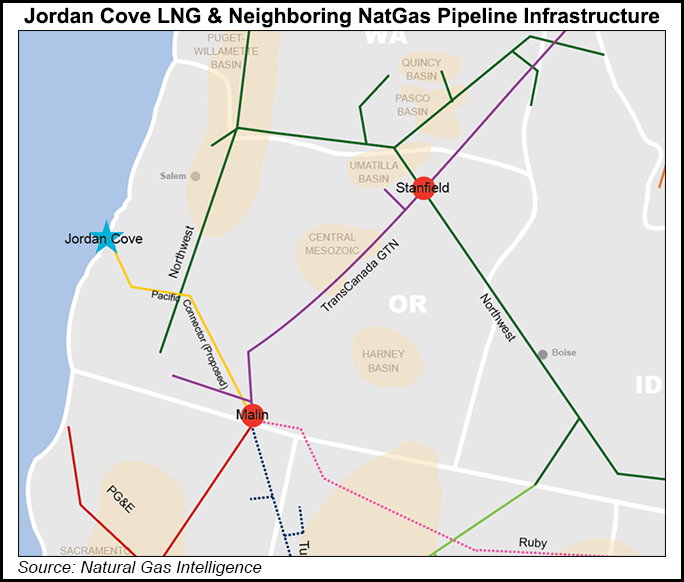Regulatory | LNG | LNG Insight | NGI All News Access | NGI The Weekly Gas Market Report
FERC Turns Down Jordan Cove LNG — For Now — And Approves Other Texas Gas Export Projects
FERC set aside a motion to authorize the Jordan Cove liquefied natural gas (LNG) project in Oregon Thursday, promising to revisit the issue in the near future, a day after the state again denied a key approval for the facility. Commissioners also approved a quartet of other LNG projects during their monthly meeting in Washington, DC.

“I’m disappointed that we were not able to vote out Jordan Cove today, but I respect my colleagues’ need for more time,” said Federal Energy Regulatory Commission Chairman Neil Chatterjee, following the 1-2 vote. “I want to reassure people that today’s vote is not a denial of Jordan Cove’s application. The application remains pending before the Commission and we will vote on this matter when we are ready.”
The motion would have authorized the siting, construction and operation of Jordan Cove and the associated Pacific Connector gas pipeline project in Coos County, OR. The project, to be capable of liquefying up to 1.04 Bcf/d for export, would include a pipeline gas conditioning facility, five liquefaction trains, two full-containment LNG storage tanks and associated equipment, an LNG loading platform and transfer line, marine facilities, and associated facilities [CP17-494, CP17-495]. As proposed, the LNG terminal would handle about 120 LNG carriers per year.
The project has cleared several regulatory hurdles and faced fierce opposition from environmental groups since it was proposed by Veresen Inc., now part of Pembina Pipeline Corp. FERC rejected an application for the project in March 2016, citing problems with its Pacific Connector pipeline link to tap Western Canada and U.S. Rockies supplies, along with a lack of contracts from buyers. The application was refiled in September 2017. FERC staff issued a final environmental impact statement for Jordan Cove and the Pacific Connector gas pipeline project in November.
The pipeline would originate at interconnections with existing pipeline systems in Klamath County, OR, and span parts of the Oregon’s Klamath, Jackson, Douglas, and Coos counties before connecting with the terminal. The nearly 229-mile, 36-inch-diameter pipeline would be capable of transporting up to 1.2 Bcf/d.
Jordan Cove would be the first natural gas export facility sited on the U.S. West Coast.
Bernard McNamee, who joined with Richard Glick in voting against Jordan Cove, said his vote was “not a hard ‘nay,'” and was based in part on a filing Wednesday by Oregon’s Department of Land Conservation and Development (DPCD), which concluded that the project is not consistent with the Oregon Coastal Management Program. As a result, FERC and the Army Corps of Engineers “cannot grant any license or permit to this project unless this objection is overridden on appeal by the U.S. Secretary of Commerce,” DPCD said in the 2,251-page filing.
“I want to see what the state of Oregon said, and I need that information to inform my decision about whether I’m ultimately going to vote for or against Jordan Cove,” McNamee said.
Oregon has also denied the project a water quality certificate and a dredging permit.
FERC also voted to deny rehearing and stay requests for the proposed Texas LNG Brownsville LLC and Annova LNG Common Infrastructure LLC projects, both to be sited in the Brownsville area on the southern tip of Texas. The votes came days after the U.S. Department of Energy (DOE) authorized exports and three months after FERC authorized their siting, construction, and operation.
Texas LNG has proposed a 4 million metric ton/year (mmty) terminal on the Brownsville Ship Channel in Cameron County, TX [CP16-116]. Houston-based Annova has proposed an LNG export terminal to include six liquefaction trains, each with a nameplate capacity of 1 mmty, for an aggregate nameplate capacity of 6 mmty and a maximum output at optimal operating conditions of 6.95 mmty on the Brownsville Ship Channel [CP16-480].
Commissioners also authorized the second phase of the Natural Gas Pipeline Company of America LLC (NGPL) Gulf Coast Southbound Project, a 300,000 Dth/d expansion focused on supplying LNG export demand in South Texas [CP19-99]. NGPL proposes to add horsepower at existing compressor stations in Victoria, Wharton and Harrison counties, and construct and operate auxiliary facilities at compressor stations in Angelina and Cass counties.
Cheniere Energy Inc. subsidiary Corpus Christi Liquefaction LLC has a precedent agreement for the full 300,000 Dth/d of incremental firm capacity from the expansion, which is designed to allow additional volumes to move south from an existing interconnect with the Alliance Pipeline in Grundy County, IL, to a delivery point with Cheniere Corpus Christi Pipeline LP in San Patricio County, TX. The additional capacity is to supply Train 3 at the Corpus Christi LNG terminal, according to NGPL’s filing.
Finally, FERC gave conditional approval to a Sabine Pass LNG proposal to site, construct and operate a third marine berth and supporting facilities at the existing Sabine Pass terminal in Cameron Parish, LA [CP19-11]. The project is designed to alleviate existing LNG loading, shipping and operational constraints for the liquefaction, storage and export of domestically-produced gas, FERC said.
© 2024 Natural Gas Intelligence. All rights reserved.
ISSN © 1532-1231 | ISSN © 2577-9877 | ISSN © 1532-1266 |
